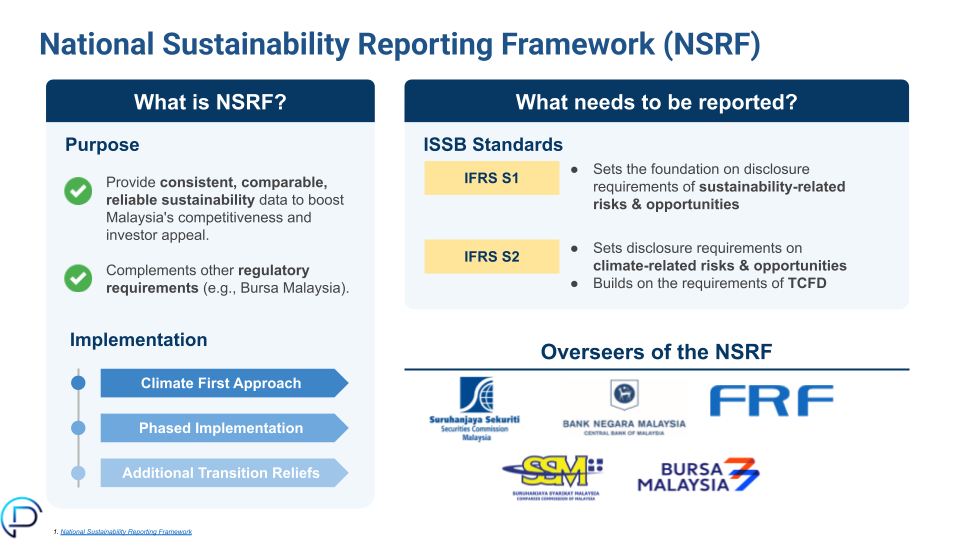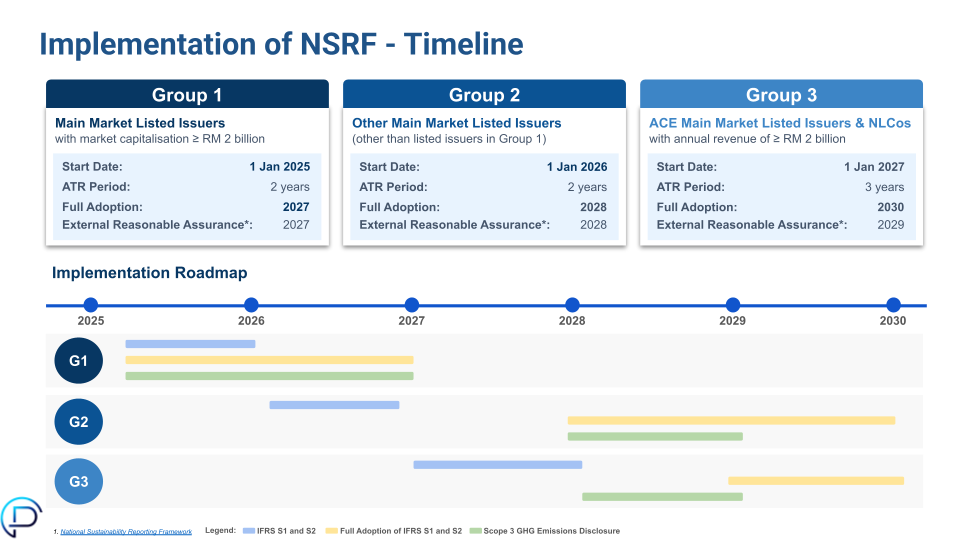A new standard for Malaysian business is no longer optional. The arrival of the National Sustainability Reporting Framework (NSRF), mandated by the Companies Commission of Malaysia (SSM), marks a significant shift in corporate accountability. For many, this presents a complex new challenge. For us at Pantas, it’s the landscape we were built for.
As Malaysia's leading experts in climate and sustainability reporting technology, we've created this definitive guide to give your business a clear and confident path to not just compliance, but leadership. The era of sustainability as a footnote is over; it's now a core component of your financial and strategic identity.
What is the National Sustainability Reporting Framework (NSRF)?

At its core, the NSRF aligns Malaysia with the highest global standards for sustainability disclosure. It adopts the new standards from the International Sustainability Standards Board (ISSB)—specifically IFRS S1 (General Requirements) and IFRS S2 (Climate-related Disclosures). This isn't just another local requirement; it's about speaking the same language as international investors and stakeholders.
For your business, this means reporting on sustainability with the same rigour as your financial statements. The framework is built on four key pillars:
Governance: Who is overseeing sustainability risks and opportunities? You need to disclose the governance bodies and management processes responsible for your company's sustainability strategy.
Strategy: How do sustainability issues impact your business model and strategy? This requires you to identify and explain the significant climate-related risks and opportunities your business faces over the short, medium, and long term.
Risk Management: How do you identify, assess, and manage sustainability risks? Companies must describe their processes for integrating these risks into their overall risk management framework.
Metrics & Targets: What data are you using to measure your performance? This is where the numbers come in. You must disclose quantitative and qualitative performance metrics, including greenhouse gas (GHG) emissions (Scope 1, 2, and the challenging Scope 3), and the targets you've set for improvement.
The Clock is Ticking: NSRF Deadlines You Can't Ignore
The NSRF is being rolled out in phases, but the first deadline is fast approaching. Urgency is key. Here’s a breakdown of when your company needs to comply, based on financial years ending on or after the dates below:

This phased approach gives businesses time to adapt, but the work needs to start now. The data requirements, especially for historical performance and Scope 3 emissions, are extensive and cannot be compiled overnight.
Why Spreadsheets and Manual Processes Will Fail the NSRF Audit
We see it all the time: companies attempt to manage complex ESG data using a patchwork of spreadsheets. While familiar, this approach is the single biggest risk to achieving NSRF compliance. It's a recipe for manual chaos.
Here are the inherent risks that make spreadsheets unfit for this new era of reporting:
Data Silos and Errors: Information is scattered across departments in different formats, leading to inconsistencies and a high risk of human error. One wrong formula can compromise your entire report.
No Audit Trail: The NSRF demands assurance-ready data. Spreadsheets offer zero visibility into how data was entered, changed, or approved, making it impossible to prove its integrity to auditors.
Inability to Scale: Manually collecting and calculating data for dozens of facilities, let alone your entire value chain for Scope 3 emissions, is an immense, time-consuming burden that simply isn't sustainable.
Lack of Strategic Insight: Spreadsheets are static. They can't provide the real-time insights needed to manage risks, identify opportunities, or make strategic decisions based on your sustainability performance.
Framed simply, the problem is that traditional tools cannot handle the complexity, scale, and rigour demanded by a global standard like the NSRF.
The Pantas Blueprint for Flawless NSRF Compliance
This is where we, Pantas, turn a regulatory burden into a strategic advantage. Our platform was purpose-built to solve the exact challenges the NSRF presents. We move our clients from manual chaos to automated clarity. Here’s how our solution directly maps to your compliance needs:
Automate Everything: Our powerful data engine connects directly to your existing systems—ERPs, accounting software, utility providers—through APIs, OCR, and seamless file uploads. This eliminates manual data entry, reduces errors to near-zero, and frees up your team to focus on strategy, not spreadsheets.
Achieve Assurance-Ready Data: Every single data point in the Pantas platform is tracked and time-stamped. Our built-in Maker/Checker workflow ensures that data is reviewed and approved before it's finalized, providing a full, transparent audit trail that will give your assurance providers complete confidence.
Master IFRS S1 & S2: Our platform isn't just compatible with the new standards; it has IFRS S1 and S2 built into its DNA. We provide the frameworks and tools you need to report against every requirement of the NSRF, from governance disclosures to climate-related financial impacts.
Conquer Scope 3 Complexity: Calculating Scope 3 emissions is notoriously difficult, but it's our specialty. Our platform has the methodologies and datasets to accurately calculate emissions across all 15 categories, turning the most challenging part of the NSRF into one of your biggest strengths.
We are not a self-service tool. We are your full-service partner, providing a fully customized solution with expert onboarding and strategic advisory to ensure you meet every deadline with confidence.
NSRF FAQ
We've been guiding clients through this transition, and a few key questions come up frequently. Here are our expert answers:
Q1: How does the NSRF differ from Bursa's previous sustainability reporting rules?
The biggest difference is the shift from a voluntary, flexible framework to a mandatory, globally-aligned one. The NSRF adopts the IFRS S1 and S2 standards, which demand more rigorous, data-driven, and financially-integrated disclosures, especially around climate. It moves beyond a narrative-based report to one that requires hard data, risk analysis, and forward-looking targets, similar to financial reporting.
Q2: Our data is a mess. How long does it take to get started with a platform like Pantas?
This is a common concern, and it's why we've designed our onboarding to be efficient and hands-on. While every company is different, we can typically move a client from initial data discovery to having an automated, assurance-ready reporting system in a matter of time. Our team of experts handles the heavy lifting of data integration and setup, allowing you to see value almost immediately.
Q3: Is the NSRF only about climate, or does it cover broader ESG topics?
The initial focus, or the "climate-first" approach, is on IFRS S2, which deals with climate-related disclosures. However, IFRS S1 covers general sustainability-related financial information, which opens the door to reporting on other material ESG topics like biodiversity, water usage, and social issues. While climate is the urgent priority, the framework is designed to expand. With Pantas, you'll be ready for what's next.
Your Next Step: Master the NSRF with Pantas
The National Sustainability Reporting Framework is a complex mandate, but it's entirely manageable with the right technology and the right partner. This is a moment to move beyond compliance and leverage sustainability as a driver for value, efficiency, and competitive advantage.
Stop worrying about compliance and start building value. See exactly how Pantas can automate your NSRF reporting and deliver assurance-ready data in a personalised demo.

